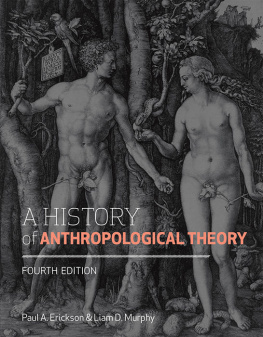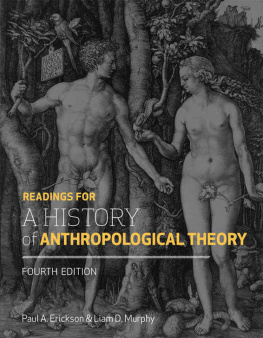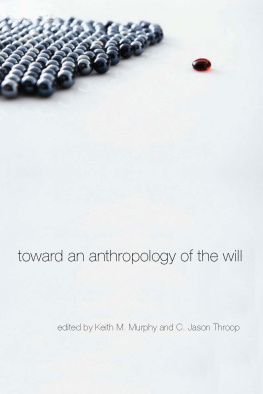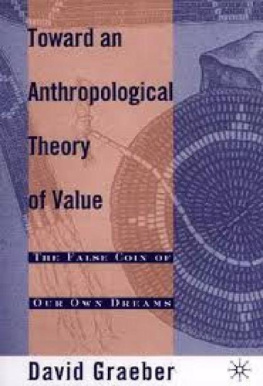A History of Anthropological Theory
Fourth Edition
Paul A. Erickson & Liam D. Murphy

Copyright University of Toronto Press Incorporated 2013
Higher Education Division
www.utppublishing.com
All rights reserved. The use of any part of this publication reproduced, transmitted in any form or by any means, electronic, mechanical, photocopying, recording, or otherwise, or stored in a retrieval system, without prior written consent of the publisheror in the case of photocopying, a licence from Access Copyright (Canadian Copyright Licensing Agency), One Yonge Street, Suite 1900, Toronto, Ontario M5E 1E5is an infringement of the copyright law.
Library and Archives Canada Cataloguing in Publication
Erickson, Paul A. A history of anthropological theory / Paul A. Erickson & Liam D. Murphy. 4th ed. Includes bibliographical references and index. Issued also in electronic formats. ISBN 978-1-4426-0659-3 (pbk.) ISBN 978-1-4426-0769-9 (bound) 1. AnthropologyPhilosophyTextbooks. 2. AnthropologyHistoryTextbooks. I. Murphy, Liam Donat II. Title. GN33.E74 2013 301.01 C2012-908011-X
We welcome comments and suggestions regarding any aspect of our publicationsplease feel free to contact us at news@utphighereducation.com or visit our Internet site at www.utppublishing.com.
North America
5201 Dufferin Street
North York, Ontario, Canada, M3H 5T8
2250 Military Road
Tonawanda, New York, USA, 14150
ORDERS PHONE : 18005659523
ORDERS FAX : 18002219985
ORDERS E-MAIL : utpbooks@utpress.utoronto.ca
Ireland, and continental Europe
NBN International
Estover Road, Plymouth, PL6 7PY, UK
ORDERS FAX : 44 (0) 1752 202333
ORDERS PHONE : 44 (0) 1752 202301
ORDERS E-MAIL : enquiries@nbninternational.com
Every effort has been made to contact copyright holders; in the event of an error or omission, please notify the publisher.
The University of Toronto Press acknowledges the financial support for its publishing activities of the Government of Canada through the Canada Book Fund.
Printed in Canada
For Dawn
For Siobhan
Preface
Some time ago, Paul Erickson organized a session of papers presented at an annual meeting of the American Anthropological Association exploring the theme Teaching the History of Anthropological Theory: Strategies for Success. His own paper was a survey of courses in the history of anthropological theory taught at colleges and universities throughout Canada and the United States. The survey revealed that such courses were widespread in both graduate and undergraduate curricula. It also revealed that, owing to the diversified nature of anthropology, there was considerable variation in the scope of the courses and the way they were taught. Especially noteworthy were the great variation in texts and professors serious dissatisfaction with their suitability. A recurring complaint of professors was, We need a suitable textbook.
Shortly thereafter, Erickson and Liam Murphy began a rich conversation concerning the history of anthropological theory that marked the beginning of a sustained dialogue with the ancestors. Appropriately, this dialogue has been mirrored in the relations between the authors themselves: Erickson, the professor, and Murphy, the erstwhile student, himself turned professor. To date, this conversation has yielded the twin successes of three editions of A History of Anthropological Theory and its companion volume, Readings for a History of Anthropological Theory.
In the beginning, A History of Anthropological Theory was broadly based on a senior-level undergraduate course that Erickson had been teaching at Saint Marys University for many years, a course in which Murphy himself was enrolled while a student there. As with any university course, this one had evolved through the incorporation of elements of various texts used on and off for years. These included Paul Bohannan and Mark Glazers High Points in Anthropology (1989), Peter Bowlers Evolution (1989), Annemarie de Waal Malefijts Images of Man (1974), Bruce Triggers A History of Archaeological Thought (1990), and Marvin Harriss The Rise of Anthropological Theory (1968) and Cultural Materialism (1979). The second, third, and now fourth editions of A History of Anthropological Theory have incorporated more of Murphys bibliographic sources, especially pertaining to the later twentieth century, when he joined the profession. Although the book has not been written from any of these other authors theoretical perspectives, its presentation and interpretation in places may be similar. Therefore, we are indebted to the authors for inspiration and for an organization of material that works in the classroom. Over the years, in the subsequent editions, we have put more and more of our own stamp on the book, especially in presenting theories of the later twentieth and early twenty-first centuries. If certain theories or theorists appear to have been left out, the reason is not disrespect, but rather our desire to keep the book brief.
In the main, our fourth edition adopts the North American four-field framework for anthropology as a general discipline with specialized subfields of linguistic, archaeological, physical, and cultural anthropology. We acknowledge that in the early twenty-first century, the four-field framework is under stress, and we in fact discuss that stress in our conclusion. Nevertheless, most North American anthropology remains cultural anthropology, so the book concentrates on this subfieldbut not exclusively. It includes key sections on linguistic, archaeological, and physical anthropology that can be read with profit by all anthropology students. Unlike many comparable texts, which begin in the eighteenth or nineteenth century, our book begins in antiquity, in the understanding that all subdisciplines of anthropology are deeply rooted in Western experience.
This fourth edition of A History of Anthropological Theory incorporates some exciting changes to earlier editions and is probably the most changed edition so far. The text has been expanded from three to four parts, with the fourth part comprising anthropological theory in the early twenty-first century. There is a new section on world traditions in anthropology; an extended discussion of postcolonial theory has been added to the section on political economy; and the section on public anthropology now concludes with a discussion of the United States armys controversial Human Terrain System (HTS) program. Elsewhere, notably in the conclusion, the text has been updated, as have sources and suggested readings. In previous editions, the questions at the end of the book were review questions that focused somewhat matter-of-factly on the main points of the books sections. In the fourth edition, almost all of these questions have been replaced by questions designed less as straightforward reviews and more as vehicles to engage students with the material in novel ways. We hope that these questions will encourage students to think rather than merely recapitulate. Users of previous editions of the book will definitely notice that the fourth edition has a new look. Gone are the boldfaced terms and associated marginal definitions. In their place are lists of key words that precede most sections. All along, we have attempted to define important words the first time we use them in the text. Therefore, upon reflection, it occurred to us that the marginal definitions were somewhat redundant, especially because the definitions were repeated in the end-of-book glossary. Removing the boldface and marginal definitions has the added benefit of making the pages look less cluttered. Now, as students begin to read each section, they will be alerted to words that we think are key to an understanding of that section, words that are still defined in the glossary. Also contributing to the new look are many new images, which we hope readers and viewers will find dynamic, engaging, and thought-provoking. Finally, the guest essays titled Speaking about Anthropological Theory, which debuted in the third edition, have been relocated to a new website linked to the University of Toronto Press (www.utpteachingculture.com/teaching-theory). This site, which also supports the fourth edition of








